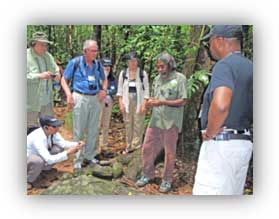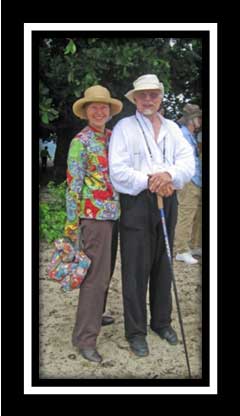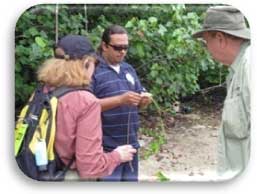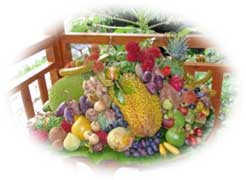PORT DOUGLAS (NORTHEAST QUEENSLAND, AUSTRALIA)
 We visited the Port Douglas area five years ago and, to the extent that a one day tourist visit can possibly do it (it can't), we saw a tiny and fascinating example of the Great Barrier Reef. On this trip we could choose a one-day excursion to either the Reef or to the Rain Forest. The Rain Forest option was a walk, followed by a walk on a nearby beach, followed by a walk in a botanical garden. The idea of walking appealed to us after all the airplane sitting but it was simultaneously a bad idea because today turned out to be a 90 degree-90 percent + humidity day. (The good news was that it didn't rain, although it did yesterday- -and torrentially. Today was partly cloudy sky with sunshine, actually a beautiful day.) We visited the Port Douglas area five years ago and, to the extent that a one day tourist visit can possibly do it (it can't), we saw a tiny and fascinating example of the Great Barrier Reef. On this trip we could choose a one-day excursion to either the Reef or to the Rain Forest. The Rain Forest option was a walk, followed by a walk on a nearby beach, followed by a walk in a botanical garden. The idea of walking appealed to us after all the airplane sitting but it was simultaneously a bad idea because today turned out to be a 90 degree-90 percent + humidity day. (The good news was that it didn't rain, although it did yesterday- -and torrentially. Today was partly cloudy sky with sunshine, actually a beautiful day.)
About 20 of us chose the Rain Forest option. We first went for a walk in the Daintree Rain Forest, led by an Aboriginal guide. He had strong and distinctive Aboriginal features and was both knowledgeable and funny, in playful colloquial English. Among many other interesting plants he pointed out on our walk, he talked about the "sticky bean" tree, which the Aboriginals used to catch birds: bird feathers become gummed up in the tree's tar-like sap and they can't fly, making them easy to catch. Another tree, the milky pine, has sap and bark that the Aboriginals crushed and then dropped into a still water pool, where it semi-stunned (but didn't poison) the fish. The milky pine potion caused the fish to rise to the surface for easy catching. Because it had rained heavily the day before our walk, we were seeing these trees and all the others he described in humidity so high it felt like we were swimming.
 Our second walk was on a beach about a half hour away. The beach was shallow enough to have mangroves growing in it. Our guide talked about how the Aborginals did and still do use the wide variety of plants growing right at the edge of the beach for food and medicine. As one fascinating example, he stopped at a large tree near the beach and pointed out some green ants. He said that after Europeans brought colds and flu to Australia, the native people learned that licking these green ants (which taste rather lemony) can clear up cold symptoms. (The ants are Our second walk was on a beach about a half hour away. The beach was shallow enough to have mangroves growing in it. Our guide talked about how the Aborginals did and still do use the wide variety of plants growing right at the edge of the beach for food and medicine. As one fascinating example, he stopped at a large tree near the beach and pointed out some green ants. He said that after Europeans brought colds and flu to Australia, the native people learned that licking these green ants (which taste rather lemony) can clear up cold symptoms. (The ants are  licked and then let go, still quite alive and rambunctous.) The walk on the beach was fairly short, but even more humid than the rain forest. After we left the beach we went to the guide's home (just across the street) for a "show and tell" about various marine animals. We were served tea and "damper," an Aboriginal "bush" bread that is moist, chewy, and delicious. licked and then let go, still quite alive and rambunctous.) The walk on the beach was fairly short, but even more humid than the rain forest. After we left the beach we went to the guide's home (just across the street) for a "show and tell" about various marine animals. We were served tea and "damper," an Aboriginal "bush" bread that is moist, chewy, and delicious.
Our last stop was a botanical garden created by a couple, Alan and Susan Carle, who came to Australia in the late 1960's. In the early 1980's they purchased 20 acres of sloped land north of Port Douglas, part of the greater  Daintree Rain Forest area, that had been used to grow sugar cane since the early twenties. When harvesting equipment came into common use (which couldn't easily be used on the sloping hills), the land was sold to cattle ranchers. The ranchers then further stripped the land to grow grass for cattle feed. Alan and Susan bought these 20 acres and, working by themselves, took what was at that point barren and starved land and restored that land into a fabulous site they call the BotanicalArk, which is Rain Forest "Restored." What started as their attempt to grow everything they and their daughters would need to live off the land turned into a passion to collect and grow tropical plants from all over the world. A parcel of land that was depleted and unproductive was turned into a veritable tropical jungle of flowers and trees and bushes that produces fruit, nuts, spices, medicinal and other plants. Daintree Rain Forest area, that had been used to grow sugar cane since the early twenties. When harvesting equipment came into common use (which couldn't easily be used on the sloping hills), the land was sold to cattle ranchers. The ranchers then further stripped the land to grow grass for cattle feed. Alan and Susan bought these 20 acres and, working by themselves, took what was at that point barren and starved land and restored that land into a fabulous site they call the BotanicalArk, which is Rain Forest "Restored." What started as their attempt to grow everything they and their daughters would need to live off the land turned into a passion to collect and grow tropical plants from all over the world. A parcel of land that was depleted and unproductive was turned into a veritable tropical jungle of flowers and trees and bushes that produces fruit, nuts, spices, medicinal and other plants.
They live in the midst of their recreated rain forest and designed/built their home both for family and, by pre-arrangement, for groups such as National Geographic to visit. Our tour ended with an extraordinary lunch using fruits and vegetables grown on the property - delicious! Then, at the end of the meal, they gave us something called the "miracle fruit." What this small berry does is basically change the tongue's taste receptors for several hours to make everything that is eaten taste sweet. To demonstrate this, we were all given very sour lemons and told to lick them (we all puckered-the lemons were very sour). Then we put the small olive-sized "miracle" berry in our mouth, bit off the thin fruit covering the seed, and chewed that fruit layer for several minutes. We then spit out the seed and tasted the lemon again. The lemon that earlier made all of us pucker now tasted wonderfully sweet! This berry does something to the tongue's taste receptors with (perhaps) a protein. Whatever the technical explanation, it was a blazingly clear example of why they are so committed to trying to save the "knowns and unknowns" of the world's rainforests.
< PREV | NEXT >
|
 We visited the Port Douglas area five years ago and, to the extent that a one day tourist visit can possibly do it (it can't), we saw a tiny and fascinating example of the Great Barrier Reef. On this trip we could choose a one-day excursion to either the Reef or to the Rain Forest. The Rain Forest option was a walk, followed by a walk on a nearby beach, followed by a walk in a botanical garden. The idea of walking appealed to us after all the airplane sitting but it was simultaneously a bad idea because today turned out to be a 90 degree-90 percent + humidity day. (The good news was that it didn't rain, although it did yesterday- -and torrentially. Today was partly cloudy sky with sunshine, actually a beautiful day.)
We visited the Port Douglas area five years ago and, to the extent that a one day tourist visit can possibly do it (it can't), we saw a tiny and fascinating example of the Great Barrier Reef. On this trip we could choose a one-day excursion to either the Reef or to the Rain Forest. The Rain Forest option was a walk, followed by a walk on a nearby beach, followed by a walk in a botanical garden. The idea of walking appealed to us after all the airplane sitting but it was simultaneously a bad idea because today turned out to be a 90 degree-90 percent + humidity day. (The good news was that it didn't rain, although it did yesterday- -and torrentially. Today was partly cloudy sky with sunshine, actually a beautiful day.)
 Our second walk was on a beach about a half hour away. The beach was shallow enough to have mangroves growing in it. Our guide talked about how the Aborginals did and still do use the wide variety of plants growing right at the edge of the beach for food and medicine. As one fascinating example, he stopped at a large tree near the beach and pointed out some green ants. He said that after Europeans brought colds and flu to Australia, the native people learned that licking these green ants (which taste rather lemony) can clear up cold symptoms. (The ants are
Our second walk was on a beach about a half hour away. The beach was shallow enough to have mangroves growing in it. Our guide talked about how the Aborginals did and still do use the wide variety of plants growing right at the edge of the beach for food and medicine. As one fascinating example, he stopped at a large tree near the beach and pointed out some green ants. He said that after Europeans brought colds and flu to Australia, the native people learned that licking these green ants (which taste rather lemony) can clear up cold symptoms. (The ants are  licked and then let go, still quite alive and rambunctous.) The walk on the beach was fairly short, but even more humid than the rain forest. After we left the beach we went to the guide's home (just across the street) for a "show and tell" about various marine animals. We were served tea and "damper," an Aboriginal "bush" bread that is moist, chewy, and delicious.
licked and then let go, still quite alive and rambunctous.) The walk on the beach was fairly short, but even more humid than the rain forest. After we left the beach we went to the guide's home (just across the street) for a "show and tell" about various marine animals. We were served tea and "damper," an Aboriginal "bush" bread that is moist, chewy, and delicious.  Daintree Rain Forest area, that had been used to grow sugar cane since the early twenties. When harvesting equipment came into common use (which couldn't easily be used on the sloping hills), the land was sold to cattle ranchers. The ranchers then further stripped the land to grow grass for cattle feed. Alan and Susan bought these 20 acres and, working by themselves, took what was at that point barren and starved land and restored that land into a fabulous site they call the BotanicalArk, which is Rain Forest "Restored." What started as their attempt to grow everything they and their daughters would need to live off the land turned into a passion to collect and grow tropical plants from all over the world. A parcel of land that was depleted and unproductive was turned into a veritable tropical jungle of flowers and trees and bushes that produces fruit, nuts, spices, medicinal and other plants.
Daintree Rain Forest area, that had been used to grow sugar cane since the early twenties. When harvesting equipment came into common use (which couldn't easily be used on the sloping hills), the land was sold to cattle ranchers. The ranchers then further stripped the land to grow grass for cattle feed. Alan and Susan bought these 20 acres and, working by themselves, took what was at that point barren and starved land and restored that land into a fabulous site they call the BotanicalArk, which is Rain Forest "Restored." What started as their attempt to grow everything they and their daughters would need to live off the land turned into a passion to collect and grow tropical plants from all over the world. A parcel of land that was depleted and unproductive was turned into a veritable tropical jungle of flowers and trees and bushes that produces fruit, nuts, spices, medicinal and other plants.